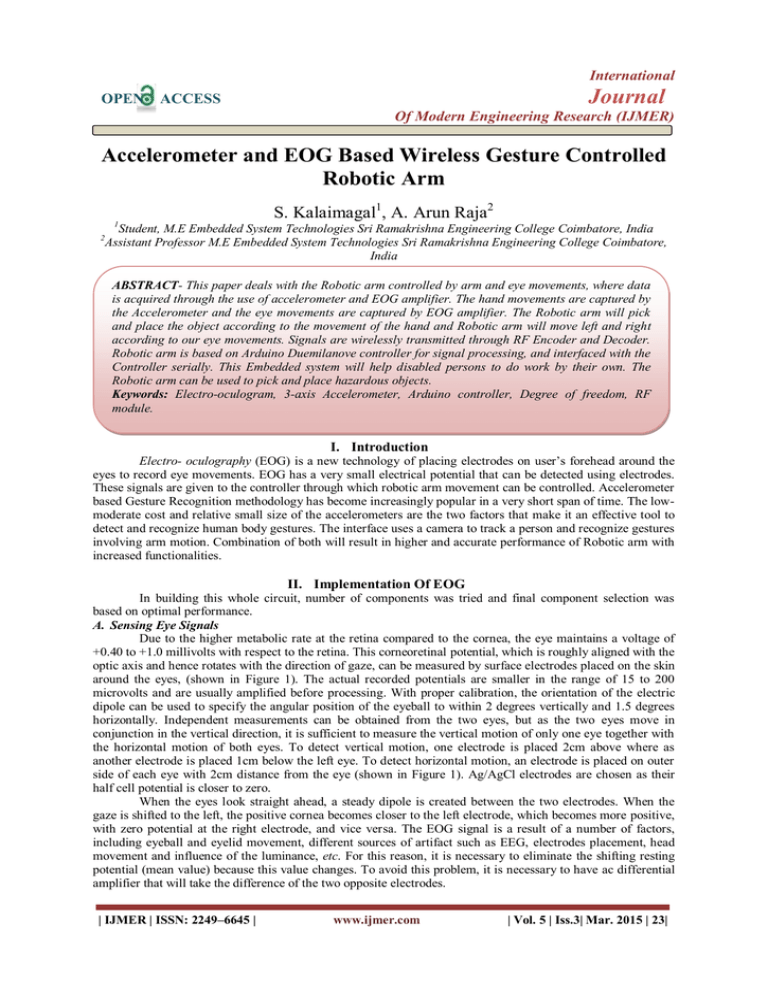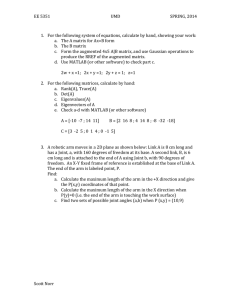Paper Title (use style: paper title)
advertisement

International OPEN Journal ACCESS Of Modern Engineering Research (IJMER) Accelerometer and EOG Based Wireless Gesture Controlled Robotic Arm S. Kalaimagal1, A. Arun Raja2 1 2 Student, M.E Embedded System Technologies Sri Ramakrishna Engineering College Coimbatore, India Assistant Professor M.E Embedded System Technologies Sri Ramakrishna Engineering College Coimbatore, India ABSTRACT- This paper deals with the Robotic arm controlled by arm and eye movements, where data is acquired through the use of accelerometer and EOG amplifier. The hand movements are captured by the Accelerometer and the eye movements are captured by EOG amplifier. The Robotic arm will pick and place the object according to the movement of the hand and Robotic arm will move left and right according to our eye movements. Signals are wirelessly transmitted through RF Encoder and Decoder. Robotic arm is based on Arduino Duemilanove controller for signal processing, and interfaced with the Controller serially. This Embedded system will help disabled persons to do work by their own. The Robotic arm can be used to pick and place hazardous objects. Keywords: Electro-oculogram, 3-axis Accelerometer, Arduino controller, Degree of freedom, RF module. I. Introduction Electro- oculography (EOG) is a new technology of placing electrodes on user’s forehead around the eyes to record eye movements. EOG has a very small electrical potential that can be detected using electrodes. These signals are given to the controller through which robotic arm movement can be controlled. Accelerometer based Gesture Recognition methodology has become increasingly popular in a very short span of time. The lowmoderate cost and relative small size of the accelerometers are the two factors that make it an effective tool to detect and recognize human body gestures. The interface uses a camera to track a person and recognize gestures involving arm motion. Combination of both will result in higher and accurate performance of Robotic arm with increased functionalities. II. Implementation Of EOG In building this whole circuit, number of components was tried and final component selection was based on optimal performance. A. Sensing Eye Signals Due to the higher metabolic rate at the retina compared to the cornea, the eye maintains a voltage of +0.40 to +1.0 millivolts with respect to the retina. This corneoretinal potential, which is roughly aligned with the optic axis and hence rotates with the direction of gaze, can be measured by surface electrodes placed on the skin around the eyes, (shown in Figure 1). The actual recorded potentials are smaller in the range of 15 to 200 microvolts and are usually amplified before processing. With proper calibration, the orientation of the electric dipole can be used to specify the angular position of the eyeball to within 2 degrees vertically and 1.5 degrees horizontally. Independent measurements can be obtained from the two eyes, but as the two eyes move in conjunction in the vertical direction, it is sufficient to measure the vertical motion of only one eye together with the horizontal motion of both eyes. To detect vertical motion, one electrode is placed 2cm above where as another electrode is placed 1cm below the left eye. To detect horizontal motion, an electrode is placed on outer side of each eye with 2cm distance from the eye (shown in Figure 1). Ag/AgCl electrodes are chosen as their half cell potential is closer to zero. When the eyes look straight ahead, a steady dipole is created between the two electrodes. When the gaze is shifted to the left, the positive cornea becomes closer to the left electrode, which becomes more positive, with zero potential at the right electrode, and vice versa. The EOG signal is a result of a number of factors, including eyeball and eyelid movement, different sources of artifact such as EEG, electrodes placement, head movement and influence of the luminance, etc. For this reason, it is necessary to eliminate the shifting resting potential (mean value) because this value changes. To avoid this problem, it is necessary to have ac differential amplifier that will take the difference of the two opposite electrodes. | IJMER | ISSN: 2249–6645 | www.ijmer.com | Vol. 5 | Iss.3| Mar. 2015 | 23| Accelerometer and EOG Based Wireless Gesture Controlled Robotic Arm Figure 1: Correct positions of five electrodes B. Signal Amplification Number of devices was considered for signal amplification such as A0401 instrumentation amplifier with built-in filters, Eye Sense EOG amplifier, RHA1016, CED1902, but all these devices were very expensive. Some known instrumentation amplifiers were tested such as AD624, INA114, INA118, etc, but all these devices began deviating from their original behavior when applied to such a small range of inputs. There behaviors were verified on Multisim 7.0 Electronics Workbench. INA126P is an instrumentation amplifier recognized as EEG/EMG amplifier. It is selected as it can handle signals in microvolt range. Gain of 100,000 is achieved by implementing the amplification phase into two stages, each having a fixed gain of 1,000. This can help in reducing DC offset which may be added due to the skin temperature, the humidity of the air and the skin moisture, etc. As the signal is amplified, the noise may also get amplified. Radio Frequency (RF) Interference is a common source having frequency over 10k Hz. Common-mode signals present at the instrumentation amplifier’s inputs are normally greatly reduced by the amplifier’s common-mode rejection but, at RF frequencies, most instrumentation amplifiers have no common mode rejection [9]. To remove this interference and Electro- Static Discharge (ESD), a protection system in the form of an RC low pass filter with cutoff at 47 Hz is implemented at the INA126p’s inputs (shown in Figure 2). This cutoff frequency can be calculated using (1). (1) Figure 2: INA126 with RFI and ESI protection system C. Driven-Right Leg IN126P’s Common Mode Rejection Ratio (CMRR) is around 94DB. To improve it, a Driven-Right Leg circuit is implemented (shown in Figure 3). This circuit is normally used in medical operations because the devices like INA126P read a very small electrical potential from the body and treat it as the desired one. That may add to the original signal and pollute it. This circuit reads what it believes to be noise and transfers a minute signal back to the body through reference electrode to negate its effect. | IJMER | ISSN: 2249–6645 | www.ijmer.com | Vol. 5 | Iss.3| Mar. 2015 | 24| Accelerometer and EOG Based Wireless Gesture Controlled Robotic Arm Figure 3: Driven-right leg D. Q-Notch Filter The most critical problem that needs one’s attention is the power line noise. It ranges from 50 to 60Hz. The main source of this is the fact that the subject’s head behaves as an antenna allowing a capacitance to be set up between overhead fluorescent lighting and the patient’s head, with the air behaving as a dielectric. Similarly nearby electrical equipment induces power line noise, introducing interference. A simple Q-Notch filter with 60Hz cutoff is implemented after the first INA126P to counter this problem (shown in Figure 4). In applications where the rejected signal might deviate slightly from the null of the notch network, it is advantageous to lower the Q of the network. This insures some rejection over a wider range of input frequencies. The values of resistors and capacitors are selected according to (2), (3) and (4). Figure 4: Q-notch filter E. High Pass Filter Another critical issue in accurately acquiring and amplifying the EOG potential, is overcoming a substantial DC offset generated by the potential difference between the reference electrode and each of the active electrodes. This DC potential is due to the skin impedances and can be highly variable, due to skin temperature, skin moisture, the humidity of the air, time of day, etc. A single stage amplifier with a gain of 1000 or more will amplify a DC voltage to a very large value, thus possibly saturating the amplifier. A high-pass filter with a very sharp roll off (-80dB/decade) and a corner frequency of 0.14Hz, is used to reject DC. Based on the type of filter that is used (e.g. Butterworth, Bessel, Chebyscheff) the attenuation of the lower frequencies can be greater. This attenuation is also based on the order (e.g. 1st, 2nd) of the filter that is used. Based on the order of the filter, the rolloff of the filter can be calculated using the formula –n*20 dB/decade. This means that a first order high pass filter has an attenuation of -20dB/decade, while a second order filter should have - 40dB/decade rolloff and on down the list for higher orders. Rolloff of -80DB/Decade is achieved by implementing two 2nd order High Pass Filters in series. The circuit diagram is shown in Figure 5. Bessel filter is preferred since it has a fast transient response. One of such 4th order filters is implemented after Q-Notch filter during first phase of amplification. The second one is implemented after second INA126P during second phase of amplification. The values of resistors and capacitors are selected according to (5). | IJMER | ISSN: 2249–6645 | www.ijmer.com | Vol. 5 | Iss.3| Mar. 2015 | 25| Accelerometer and EOG Based Wireless Gesture Controlled Robotic Arm (5) Figure 5: 2nd order Bessel’s high pass filter F. Anti-Aliasing Filter Having passed through second INA126P, the power line noise may again come into play because this noise is always present. So whenever the signal is amplified, this noise may also get stronger. This noise can be removed by implementing a second Q-Notch filter with the same cutoff as before. But another problem that may occur is Aliasing. Aliasing may occur if the input signal has the frequency components that are greater than the half of the sampling frequency. The sampling frequency that is achieved through custom software is 100Hz. Since power line noise has frequency components that are greater than the half of the sampling frequency i.e. 50Hz in Pakistan, there is a need to implement an anti-aliasing filter. The power line noise and the aliasing effect can both be greatly reduced by implementing a sharp rolloff low pass filter (-80DB/Decade) with cutoff at 30Hz (shown in Figure 6). The cutoff frequency of the filter should be no higher than about ¼ of the sampling rate. If the sampling rate is 400Hz, for example, then set the filter’s cutoff frequency to below 100Hz. Although the required cutoff frequency was little shorter than 30Hz such as 25Hz, cutoff frequency of 30Hz is selected due to bandwidth of the EOG signal (1~25Hz). The values of resistors and capacitors are selected according to (6). Figure 6: 2nd order Bessel’s low pass filter III. Implementation Of Accelerometer A 3-axis accelerometer is a sensor that returns a real valued estimate of acceleration along the x, y and z axes from which velocity and displacement can also be estimated. Accelerometers can be used as motion detectors (DeVaul & Dunn 2001) as well as for body-position and posture sensing (Foerster, Smeja, & Fahrenberg 1999). Apple’s iLife Fall Detection sensor which embeds an accelerometer and a microcomputer to detect falls, shocks or jerky movements is a good example. Advances in miniaturization will permit accelerometers to be embedded within wrist bands, bracelets and belts and to wirelessly send data to a mobile computing device that can use the signals to make inferences. Making devices aware of the activity of the user fits into the bigger framework of context awareness. We have attempted to recognize activities using a single 3-axis accelerometer worn on hand. Data from the accelerometer has the following attributes: time, acceleration along x axis, acceleration along y axis and acceleration along z axis. We used a 3-axis accelerometer. | IJMER | ISSN: 2249–6645 | www.ijmer.com | Vol. 5 | Iss.3| Mar. 2015 | 26| Accelerometer and EOG Based Wireless Gesture Controlled Robotic Arm IV. Robotic Arm A Robotic arm is a robotic manipulator, usually programmable, with similar functions to a human arm .Servo motor is used for joint rotation. It has 5 number of degree of freedom. In order for a robot or a robotic arm to pick up or move something, someone has to tell it to perform several actions in a particular order from moving the arm, to rotating the “wrist” to opening and closing the “hand” or “fingers.” So, we can control each joint through controller interfacing. G. Robotic Arm Features The arm has five servos which are controlled through the use of only one microcontroller at-mega 16. The arm could grab things approximately in a hemisphere of 50cm and is robust made completely with an aluminium sheet of 2.5mm. The arm could lift objects up to weight of 2 kg. Enabling the base rotation without the help of any gears or ball bearing, also using only low torque servo motors and three castor wheels for rotating the whole body. V. EOG And Accelerometer Interfacing With Robotic Arm H. Transmitter Side Block Diagram Both EOG signals and Accelerometer signals fed to the Arduino duemilanove microcontroller with inbuilt ADC. The output of the microcontroller will be encoded and given to the RF Transmitter and the signal is transmitted through the Antenna. Depending upon the movements of the eye which is captured by EOG and movements (Gestures and Postures) of hand captured by the Accelerometer worn on hand, Robotic arm will performs its operations. The Block diagram of Transmitter is shown in the Figure 7. Figure 7: Transmitter side Block Diagram I. Receiver Side Block Diagram The signal received from the Antenna is given to the RF Receiver that is decoded and fed to the relay circuits. Depending on the relay function Robotic arm performs its actions like PICK and PLACE any material, moving in LEFT, RIGHT, FRONT AND BACK. The Block diagram of Receiver is shown in the Figure 8. Figure 8: Receiver side Block Diagram VI. Experimental Results J. Transmitter Side Signals received from EOG and Accelerometer is fed to the Arduino Duemilanove controller after the Signals are amplified and removed from noise. Transmitter section is shown in the Figure 9. The output of the controller is given to the encoder, after encoding the signals it is fed to the RF transmitter and transmitted wirelessly through antenna. | IJMER | ISSN: 2249–6645 | www.ijmer.com | Vol. 5 | Iss.3| Mar. 2015 | 27| Accelerometer and EOG Based Wireless Gesture Controlled Robotic Arm Figure 9: Transmitter section K. Receiver Side The signals which are received from the RF receiver are fed to the decoder. Decoder output will be given to the controller, the controller will act as multiplexer, will give eight output signals. Depending upon the signal received any one of the controller will be ON and Robotic arm will perform corresponding operations. Receiver section is shown in the Figure 10. Figure 10: Receiver section L. EOG Results The first picture is the result when we blink our eyes. The second one when we move our eyes left side. The third one when moving our eyes right side. Fourth one is when moving our eyes up. Finally fifth one is when moving our eyes down. The EOG results are shown in the Figure 11. | IJMER | ISSN: 2249–6645 | www.ijmer.com | Vol. 5 | Iss.3| Mar. 2015 | 28| Accelerometer and EOG Based Wireless Gesture Controlled Robotic Arm Figure 11: EOG results M. Final Output in LCD (i) Picking an object (iii) Gripper moves UP (ii) Placing an object (iv) Middle part moves Down (v) Normal condition Figure 12: LCD output The LCD outputs shown in the Figure 12 will clearly shows different operations of Robotic arm like pick, place, gripper up and down, middle up and down etc., N. Experimental Output Figure 13: Picking an object Figure 14: Placing an object | IJMER | ISSN: 2249–6645 | www.ijmer.com | Vol. 5 | Iss.3| Mar. 2015 | 29| Accelerometer and EOG Based Wireless Gesture Controlled Robotic Arm Figure 15: Robotic arm moves LEFT side Figure 16: Robotic arm moves RIGHT side Figure 17: Various movements of Robotic arm VII. Applications Robotic arms are the vital part of almost all the industries. In industries, a robotic arm performs various different tasks such as welding, trimming, picking and placing etc. Moreover the biggest advantage of these arms is that it can work in hazardous areas and also in the areas which cannot be accessed by human. VIII. Conclusion And Future Work The approach presented in this work detects the requirements of the subject and aims in assisting to move the object just by moving the eyeball or by blinking the eyes with a response time of 100ms, repeatability 40% and with high sensitivity. By using Accelerometer in addition to EOG will improve the performance and number of operations. And the most important thing for person with disabilities is to live like a normal man. Arduino duemilanove controller is used for interfacing DC motors of Robotic arm. From observations, it clearly shows that its movement is precise, accurate, and is easy to control and user friendly to use. This robotic arm control method overcomes the problem such as placing or picking object that away from the user, pick and place hazardous object. Advancement in this will further improve Human-machine interaction. | IJMER | ISSN: 2249–6645 | www.ijmer.com | Vol. 5 | Iss.3| Mar. 2015 | 30| Accelerometer and EOG Based Wireless Gesture Controlled Robotic Arm REFERENCES [1] [2] [3] [4] [5] [6] [7] [8] [9] [10] [11] [12] [13] Dr. R. V. Dharaskar, S. A. Chhabria, Sandeep Ganorkar, “Robotic Arm Control Using Gesture and Voice”, In International Journal of Computer, Information Technology & Bioinformatics (IJCITB), Vol. 1, Issue 1, pp. 41-46 S. Waldherr, R. Romero and S. Thrun, (2000), “A gesture based interface for human-robot interaction”, In Autonomous Robots in Springer, vol. 9, Issue 2, pp. 151-173. Bimodal Interface to Support Robotic Arm Control “Chen, J. Y. Yang, S. N. Liou, G. Y. Lee, and J. S. Wang, (2008) “Online classifier construction algorithm for human activity detection using a triaxial accelerometer,” Appl. Math. Computer, pp. 849–860. Cheok, Y. Qiu, K. Xu, and K. G. Kumar, (2007) “Combined wireless hardware and real-time computer vision interface for tangible mixed reality,” IEEE Trans. Ind. Electron., vol. 54, no. 4, pp. 2174–2189. Choi, A. S. Lee, and S. Y. Lee, (2006) “On-line handwritten character recognition with 3D accelerometer,” in Proc. IEEE Int. Conf. Inf. Acquisition, pp. 845–850. Prima Adhi Yudhistira, Joga Dharma Setiawan, Khalid bin Hasnan, (2009) “Development of Wearable Robotic Arm Input for 5 DOF Articulated Arm Manipulator” proceedings of the Seminar Nasional Tahunan Teknik Mesin (SNTTM) ke-8 Semarang, pp. 11-14. Charles Kitchin and Lew Counts, “A designer’s guide to instrumentation Amplifier”, pp. 34-36. Love Aggarwal, Varnika Gaur and Puneet Verma, (2013) “Design and Implementation of a Wireless Gesture Controlled Robotic Arm with Vision”, International Journal of Computer Applications Vol. 79 – No 13, pp.39-43. K. Murakami and H. Taguchi, (1991), “Gesture Recognition using Recurrent Neural Networks”, In Proceedings of ACM CHI’91 Conference on Human Factors in Computing Systems, pp. 237-242. J. Yang, W. Bang, E. Choi, S. Cho, J. Oh, J. Cho, S. Kim, E. Ki and D. Kim, (2006), “A 3D Hand drawn Gesture Input Device using Fuzzy ARTMAP-based Recognizer”, In Journal of Systemic, Cybernetics and Informatics, Vol. 4 Issue 3, pp. 1-7. Sylvain Calinon and Aude Billard (2007) “Active Teaching in Robot Programming by Demonstration” IEEE International Symposium on Robot and Human Interactive Communication, pp. 1-6. Arslan Qamar Malik, and Jehanzeb Ahmad “Retina Based Mouse Control (RBMC)”, (2007) proceedings of world academy of science, engineering and technology Vol. 25 ISSN 1307-6884, pp. 318-322 . Andre´s U´ Beda, Eduardo Ia´n˜ez, and Jose´ M. Azor´ın, (2011) “Wireless and Portable EOG-Based Interface for Assisting Disabled People”, IEEE/ASME Transactions on Mechatronics, Vol. 16, No. 5, pp.870-873. | IJMER | ISSN: 2249–6645 | www.ijmer.com | Vol. 5 | Iss.3| Mar. 2015 | 31|



